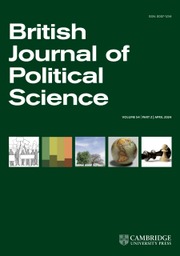Article contents
The Jeffords Switch and Public Support for Divided Government
Published online by Cambridge University Press: 21 February 2005
Extract
On 24 May 2001, US Senator James M. Jeffords of Vermont formally announced that he intended to leave the Republican party to become an Independent. Although congressional party switches in the United States are noteworthy because of their infrequency, the Jeffords switch was especially significant because he would caucus with the Democratic party, handing the Democratic party control of the Senate by a one-vote margin. When Jeffords formally left the Republican party on 5 June 2001, it was the first time that partisan control of the US Senate changed hands mid-session. Perhaps most importantly, with the House and presidency under Republican control, the Jeffords move ushered in the return of divided government – split party control of the executive and legislative branches. Indeed, Jeffords' switch received vast amounts of media attention precisely for this reason. The scant attention given to other recent party defectors in the US Senate such as Ben Nighthorse Campbell of Colorado or Robert (Bob) Smith of New Hampshire suggests that the Jeffords switch was much larger than a senator simply changing his party affiliation.
Over the last twenty years, split partisan control of the executive and legislative branches occurred in American government roughly two-thirds of the time. Given the frequency of divided government, especially in the post-war era, scholars have written much about its causes. The focus of much of this research concerns voting behaviour, especially ticket-splitting and voting against the president's party at the midterm (midterm voting). Some scholars advocate ‘cognitive madisonianism’ or ‘policy-balancing’ explanations, which posit that a subset of voters with moderate policy preferences intentionally, but not necessarily consciously, engage in ticket-splitting or midterm voting to bring about policy moderation or ‘balance’ among the parties. Others contend that ticket splitting and midterm voting is unintentional, a by-product of factors that shape voting behaviour such as candidates, partisanship and campaigns.
- Type
- Notes and Comments
- Information
- Copyright
- © 2005 Cambridge University Press
- 10
- Cited by




